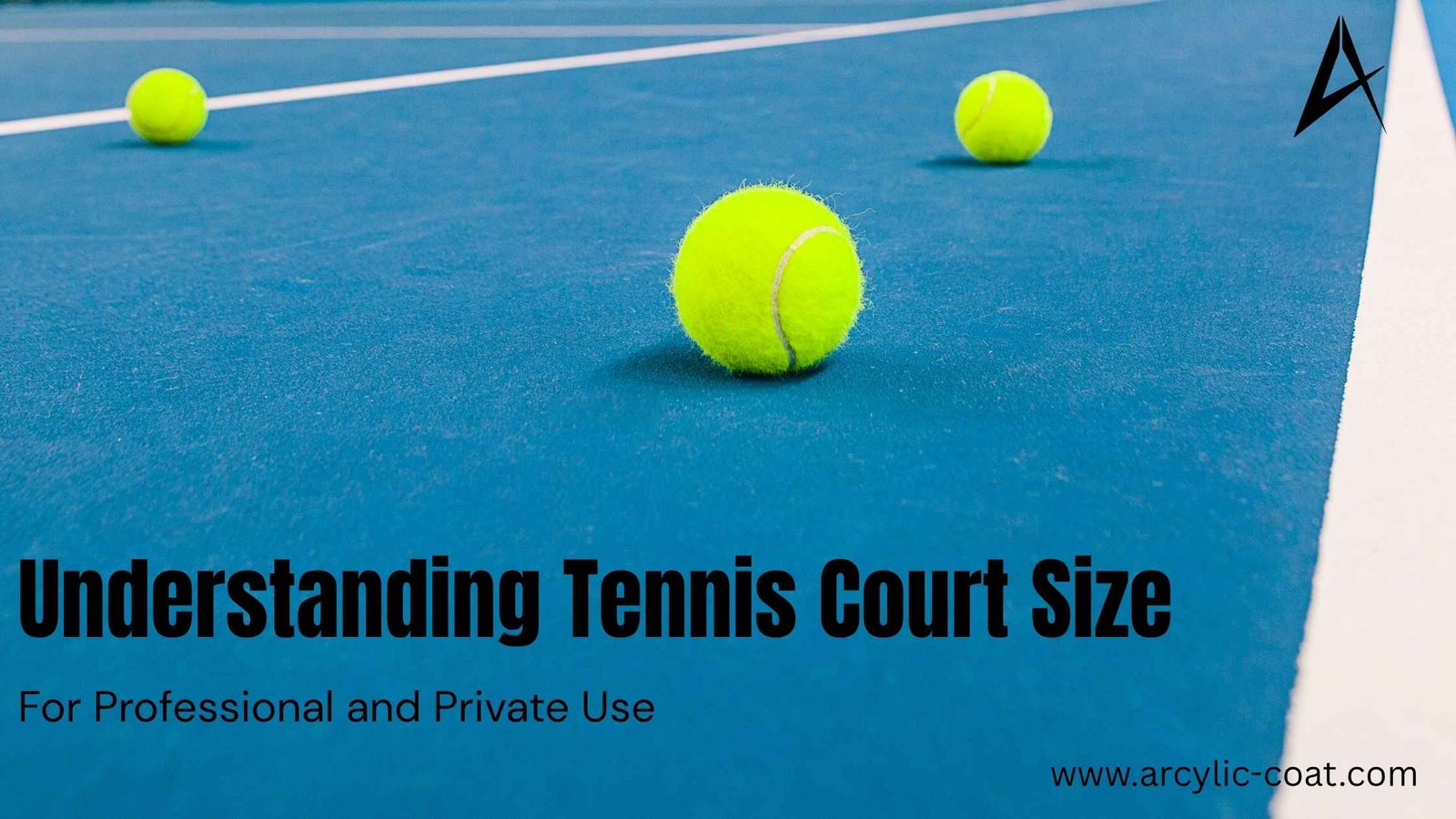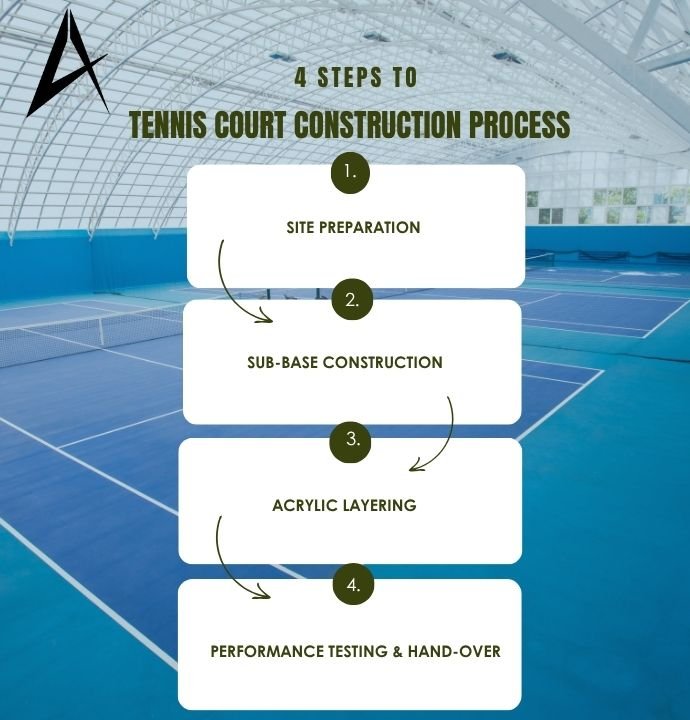
When building a tennis court—private property, sports academy, school or public park—the first thing to get right is the tennis court size. Measurements are crucial not just for compliance but for playability, safety and space utilization. A court that doesn’t meet the standards can hinder performance, player experience and in competitive scenarios even disqualify you from hosting matches.
In this guide we’ll go through standard tennis court dimensions, layout elements and show how AAL—a leader in acrylic flooring and sports surface solutions—can help you build a world class court with high quality materials and professional installation.
Tennis Court Size and Layout
When building a tennis court—whether for a home, school or sports club—getting the court size right is key. The right measurements ensure fair play, international standards and optimal use of space. An incorrectly measured court affects player experience and prevents hosting of formal matches.
According to the ITF, the official standard tennis court dimensions are:
| Area | Metric | Imperial |
| Court Length | 23.77 m | 78 ft |
| Singles Width | 8.23 m | 27 ft |
| Doubles Width | 10.97 m | 36 ft |
| Net Height (Center) | 0.914 m | 3 ft |
| Net Height (Posts) | 1.07 m | 3.5 ft |
| Service Box Length | 6.4 m | 21 ft |
If you need to accommodate both singles and doubles play, build a doubles court and paint the singles lines inside the main lines.
But it’s not just the playing area that matters. Run-off space around the court is essential for players to move safely without any risk. For non-tournament play, the recommended area is around 36.57 meters (120 ft) long and 18.29 meters (60 ft) wide, which is roughly 7,200 sq. ft. This includes the buffer zones behind the baselines and outside the sidelines. Understanding these dimensions helps in court layout, fencing, lighting installation and net post placement. Poor planning can lead to obstructions that interfere with play.
That’s where AAL, a leading provider of acrylic court surfaces in India, excels. Their engineering team offers design-to-execution tennis court solutions that follow ITF standards. By designing your court to the correct measurements and surfacing it with durable, weather resistant materials, AAL ensures safety, consistency and a professional finish.
Tennis Court Flooring & Construction with AAL
Court dimensions are only half the equation; the surface chosen determines how a tennis court feels, plays and weathers over time. For India’s heat, monsoons and year-round use, AAL’s acrylic tennis court flooring has become the standard, delivering consistent ball bounce, good grip and minimal maintenance.
Why AAL’s Acrylic Flooring Is Preferred
- All-weather durability. Formulated with UV-stable resins and water-shedding textures, the coating resists fading, cracking and slipperiness through scorching summers and heavy rains.
- Low-maintenance life cycle. Routine sweeping and occasional pressure wash is all that’s needed; resurfacing is rarely required before 5 years.
- Player-focused comfort. Optional cushion layers absorb impact and reduce joint strain, making long training sessions safer for juniors, adults and senior players.
- Design flexibility. Clients can choose tournament blues, traditional greens or institutional colours and AAL’s factory-mixed pigments ensure line markings remain sharp and bright.
AAL’s Step-by-Step Construction Process
- Site preparation. Engineers survey gradients, soil strength and drainage paths, then grade and compact the subgrade to create a stable platform.
- Sub-base construction. 100-125 mm concrete or asphalt slab is poured with 1% slope; expansion joints and curing time is strictly observed to prevent future heaving or cracking.
- Acrylic layering. After priming, technicians apply acrylic resurfacer, build up cushion coats when specified, apply 2 colour coats and finish with laser-aligned ITF line markings.
- Performance testing & hand-over. The completed surface is tested for bounce, traction and levelness; only when benchmarks are met is the court signed off and client training provided.

Custom Solutions & Quality Assurance
Not every project has space for a full 36×78 ft footprint. Schools cramped by boundary walls, rooftop leisure decks and housing-society courtyards often need smaller footprints that still feel like a real tennis court. AAL’s design team models reduced-length or multi-sport layouts, positions baselines, run-offs and fencing so that rallies flow naturally and safety clearances are maintained. Where height or weight limits apply – such as on terraces – lightweight acrylic overlays are paired with thinner, reinforced concrete slabs to keep structural loads within code.
Quality control is embedded in every stage. Laser levels verify slope, digital hygrometers test moisture before coating and pre-approved ITF templates prevent off-centre nets or skewed service boxes. Post-installation, AAL provides maintenance schedules and warranty documentation that covers tennis court material and workmanship. The result is a surface built once, built right and ready for years of play with confidence.
Special Courts, Cost Factors
Tennis isn’t one size fits all. Depending on your audience—kids, amateur adults or professional players—you can scale your court accordingly. For example:
- Kids (Red Ball Stage): 11m x 5.5m courts for 5-8 years
- Intermediate (Orange Ball): 18m x 6.5m courts for 8-10 years
- Full-sized Courts: For 11+ age, professional use and tournaments
AAL can build such multi-use tennis courts using high quality acrylic systems and help institutions like schools and clubs to serve multiple age groups.
Cost Factors in Tennis Court Construction
Cost of building a court with correct dimensions also depends on:
| Component | Estimated Cost (INR) per sq. ft |
| Concrete or Asphalt Base | ₹70 – ₹120 |
| Acrylic Surface Layer | ₹90 – ₹160 |
| Cushion Layer (Add-on) | ₹50 – ₹70 |
| Net, Poles, Lighting | Variable |
With AAL you are not only investing in world class materials but also getting technical guidance, surface warranty and post installation services.
Conclusion
A perfect tennis game starts with a perfect court. Correct tennis court size combined with high quality acrylic surfacing from AAL ensures professional playing experience, minimal injuries and long durability. Whether you are building for personal use, public access or professional training AAL gives you the confidence of a world class court built to international standards. From accurate layouts to multi layer acrylic systems AAL is leading the way in sports flooring innovation in India. Choose AAL—and build a court that performs, protects and inspires.
Frequently Asked Questions
The main difference is the width. Singles courts are 8.23 meters wide and doubles courts are 10.97 meters wide to accommodate 2 players on each side.
Sweeping regularly, pressure washing occasionally and re-coating every 5-7 years is usually enough to keep the court in top shape.
Yes. AAL’s acrylic coatings are designed to handle India’s heat, rain and UV exposure and will not crack or fade.
Average time taken is 3-5 weeks depending on site conditions, weather and if cushion or lighting systems are added.
Yes, AAL can customize the court size for schools, academies and residential spaces while maintaining the correct play area dimensions.
